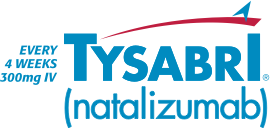EXPLORE THE ONSET OF EFFICACY OF TYSABRI
IN A POST HOC ANALYSIS OF THE AFFIRM TRIAL:
Rapid and sustained reductions in disease activity with TYSABRI1
Onset of efficacy as early as 2 months and maintained over 2 years
Study description: A post hoc analysis of the AFFIRM pivotal trial was performed to look at time to onset of clinical effects following initiation of TYSABRI® (natalizumab). ARR was calculated at 3-month intervals.a,b
Study limitations:
- Because this post hoc analysis is retrospective in nature, there are no prospectively defined endpoints
- Post hoc analyses are performed after study completion and cannot be used to demonstrate statistically significant differences between treatment groups
Rapid reduction in risk of relapse between TYSABRI and placebo first observed1:
- Day 42: In the overall population (5.4% TYSABRI vs 9.3% placebo [HR: 0.56, 95% CI: 0.34–0.93])
- Day 45: In patients with highly active disease (6.8% TYSABRI vs 16.6% placebo [HR: 0.35, 95% CI: 0.14–0.87])
aAnnualized relapse rates per 3-month interval were calculated as the total number of relapses divided by total person-years observed within the interval.
bRelapses were defined as new or recurrent neurologic symptoms not associated with fever or infection that lasted ≥24 hours and were accompanied by new neurologic signs found by the examining neurologist.
cPost hoc subgroup analysis of data from AFFIRM defined highly active disease as ≥2 relapses in the year before study entry and ≥1 T1 Gd+ MRI lesion at study entry. A total of 209 patients (148 TYSABRI and 61 placebo) in AFFIRM met the criteria for highly active MS.
This study was funded by Biogen.
